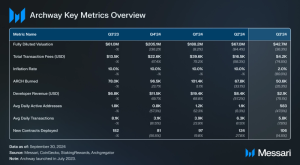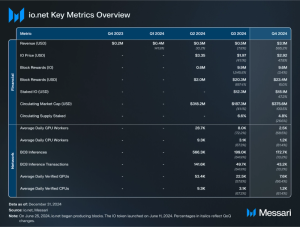Key Insights
- Algorand’s NFT Rewards program saw success as NFT-related transactions increased 321% QoQ.
- Algorand added 1.1 million new addresses and saw total daily average transactions increase by 2% QoQ.
- USDC overtook USDT in Q3, accounting for 76% of the stablecoin market cap, though Algorand’s total stablecoin market cap fell 58% QoQ.
- The Algorand Foundation kicked off the xGov program in Q3, approving seven grant applications for a total funding of 60,000 ALGO.
- Algofi, Algorand’s largest DeFi protocol by TVL, began winding down operations in July. As a result, Folks Finance became the dominant DeFi protocol on Algorand, accounting for 55% of DeFi TVL in Q3.
Primer on Algorand
Algorand is a smart contract platform employing a variant of the Proof-of-Stake (PoS) consensus mechanism, termed Pure Proof-of-Stake (PPoS). The protocol was founded by Turing award-winning computer scientist Silvio Micali, also known for co-inventing Zero-Knowledge proofs, Verifiable Random Functions (VRF), and probabilistic encryption.
Unlike other PoS smart contract protocols, Algorand currently does not reward nodes that participate in consensus, nor does it include a staking lockup or slashing mechanism. However, Algorand plans to incentivize consensus in the future. Similar to relying on stake weight in consensus, Algorand PPoS randomly selects consensus nodes based on their ALGO balances using a Verifiable Random Function (VRF), where having a larger balance increases the holder’s chance of selection.
Algorand incorporates a system of relay nodes and non-relay nodes, which can be configured as archival nodes or to participate in consensus. Algorand’s PPoS consensus protocol ensures that only one block per consensus round can be included in the chain. This process makes Algorand essentially unforkable, where the probability of forking the Algorand blockchain is roughly 10-18. Hence, if Algorand produces one block per second, it may take longer than the age of the universe (roughly 4.35 x 1017 seconds) to see one fork on the blockchain.
Algorand’s smart contract execution layer is powered by the Algorand Virtual Machine (AVM). The AVM supports applications developed in TEAL, an assembly-level programming language. After the upcoming developer preview, native Python smart contract development is expected to be released in Q1’24.
While Algorand Inc., the founding entity, is behind most of the network’s development, the Algorand Foundation is a not-for-profit organization focused on ecosystem initiatives like governance, funding Algorand-based projects, building developer tooling, and encouraging grassroots development. The Algorand ecosystem features a growing set of projects across many sectors, including DeFi, RWAs, payments, and gaming.
Key Metrics
Performance Analysis
Market Cap & Revenue
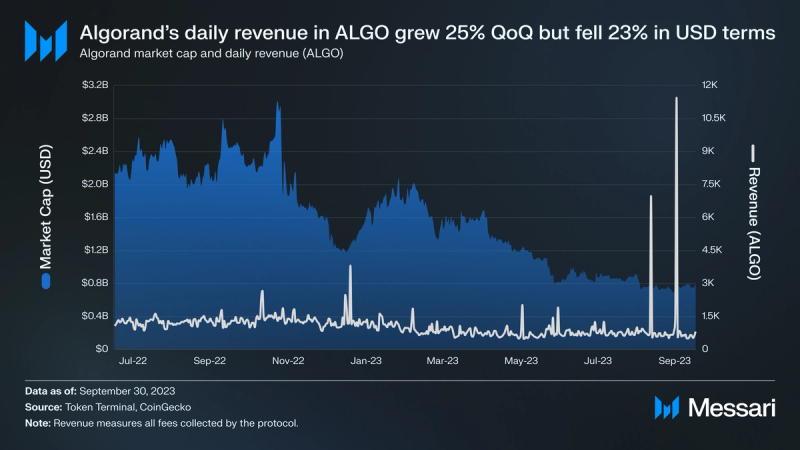
Algorand’s daily revenue (i.e., all fees collected by the protocol) grew by 25% QoQ in ALGO terms. However, in USD terms, it declined by 23% due to the 37% fall in the daily average ALGO price. Algorand’s quarter-end market cap fell in line with the entire market’s valuation, by 10% and 9%, respectively. Despite maintaining its rank close to the top 50 assets by market cap, Algorand’s P/S ratio (market cap/ annual revenue) continues to be one of the highest (lower is better) among Layer-1s.
In Q3, Algorand’s P/S ratio was over 10,000. To put this in perspective, Moonbeam, which ranks 175th based on market cap, had a P/S ratio of 471; Solana, which has the 8th largest market cap, had a P/S ratio of 579. Despite having a high market cap, Algorand has relatively low revenue, resulting from both low activity and low fees, where the average fee for an ALGO transaction is $0.0001. On the other hand, Solana’s lower P/S ratio is a result of its high activity driving revenue despite offering low fees and having a high valuation. Meanwhile, Moonbeam’s P/S ratio is largely a result of having a lower market cap and higher fees.
Addresses & Transactions
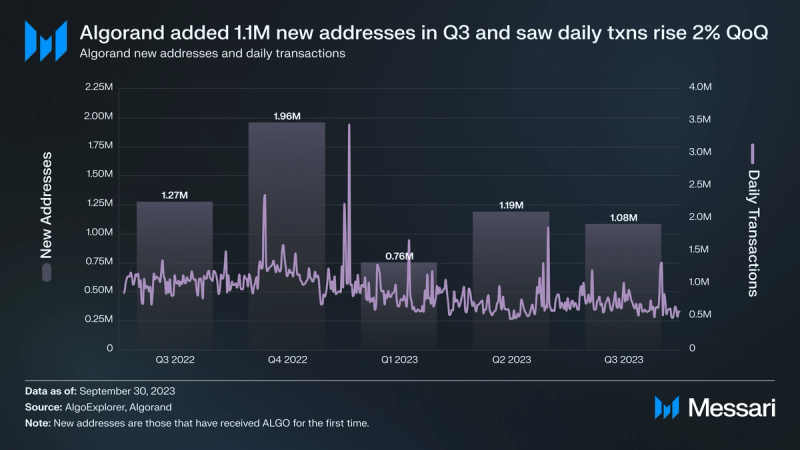
Algorand added 1.1 million new addresses in Q3, growing its total addresses by 3% QoQ. Simultaneously, Algorand processed 2% more daily transactions QoQ. This increase in transactions was likely driven by the number of transactions facilitated by NFT activity on Algorand in Q3. This metric jumped 321%, from 45,000 to 191,000. The increase in Algorand’s NFT activity was largely due to the NFT Rewards pilot program implemented in Q3. This program was enacted by a Q2 governance vote and allocated 500,000 ALGO in rewards, which ultimately went to NFT marketplace users to spur activity.
Staked ALGO
Staking ALGO for governance is different from most other chains. First, users must “commit” a certain amount to governance. If their ALGO balance falls below their commitment, then their entire stake is considered unstaked or uncommitted. Instead of directly participating in governance through the Algorand Foundation’s interface, users can also participate via Folks Finance’s Liquid Governance program, Algorand’s largest DeFi protocol as of this quarter. Its Liquid Governance program enables users to participate in governance by staking (not committing) ALGO in exchange for gALGO, a liquid governance token.
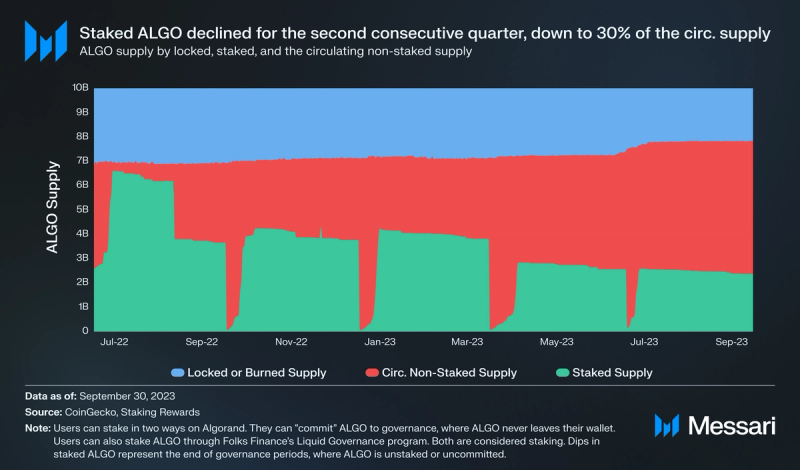
The sharp declines in staked ALGO on a quarterly basis reflect Algorand’s governance period. At the end of each period, all previously committed AGLO is unstaked or uncommitted. Each governance period lasts three months and directly corresponds to the financial quarters throughout the year. In Q3 2023, Algorand governance saw its lowest participation in the past year, falling 8% QoQ and accounting for 30% of the circulating supply. The amount of ALGO committed through Folks Finance’s Liquid Governance program in Q3 was roughly 21%.
Stablecoins
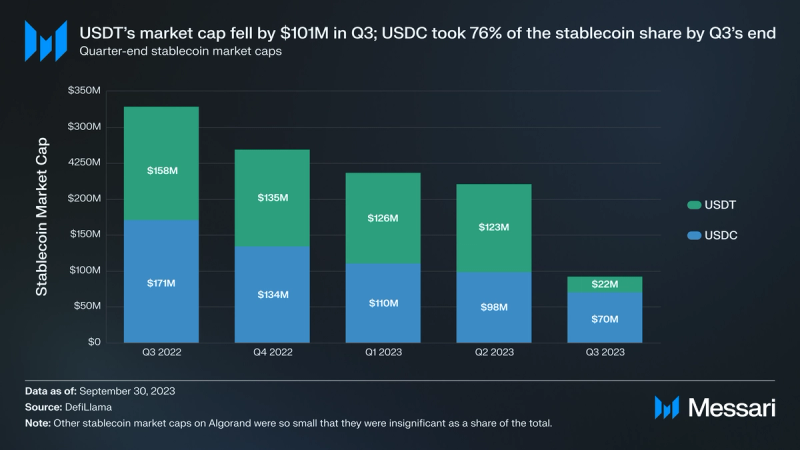
Throughout the past year, Algorand’s stablecoin market cap has declined. After falling to $92 million in Q3, it ranks 17th among all networks. With both stablecoins on Algorand consistently in decline, USDT and USDC have been contending for stablecoin dominance. They have oscillated between 44% and 56% of the total share over the last year. However, in Q3, USDT on Algorand saw outflows of $101 million, while USDC only experienced roughly $28 million in outflows. This widened the gap for USDC, enabling it to grow its share of the stablecoin market cap on Algorand to 76%.
DeFi
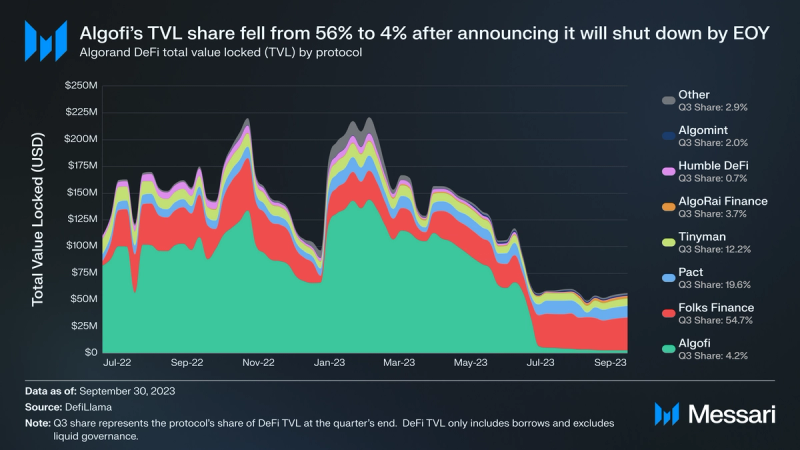
Algorand’s DeFi TVL declined by 48% in Q3 due to the shutting down of Algofi, its once largest DeFi protocol by TVL. Algofi plans to fully shut down by the end of the year. The decision to shut down was based on “a confluence of events,” without further specifications. Excluding Algofi from this quarter and the previous one, TVL would have increased by 13% QoQ; however, this does not account for the migration of former Algofi users. Folks Finance, Pact, and AlgoRai Finance are the biggest winners from Algofi’s shutdown, increasing TVL by 27%, 4%, and 246% QoQ, respectively.
Qualitative Analysis
Governance
The Algorand Foundation hosts two governance programs, Algorand Community Governance and xGov. The Community Governance program occurs on a quarterly basis and encompasses developments in the Algorand ecosystem. Governance voters that opt-in to xGov can do so during any quarter for a 12-month term with at least four voting periods. xGov voting encompasses the allocation of funding to grant applicants. Staking ALGO for xGov is not risk-free like Community Governance. xGov participants who do not vote will forfeit their staked amount, with the total amount forfeited being rewarded to participants who completed their xGov term.
- Although Governance Period 7 (GP7) occurred in Q2, proposed measures had implications into Q3. During GP7, six measures were proposed. The outcomes of each measure are listed below.
- The Algorand Foundation will continue providing liquidity to support DeFi protocols.
- Of the 50 million ALGO rewards for GP8, the DeFi rewards allocation will stay the same at 20 million ALGO.
- The Targeted DeFi Rewards program will continue for the rest of 2023.
- 7.5 million ALGO will be allocated for distribution through the Targeted DeFi Rewards program.
- The NFT Rewards program will be created with its pilot allocation starting in GP8.
- 500,000 ALGO will be allocated to the NFT Rewards program pilot.
- Governance Period 8 (GP8) occurred in Q3. During GP8, four measures were proposed. The outcomes of each measure are listed below.
- ALGO from governance rewards will be allocated to the xGov Community Grants program after the initial 2 million ALGO allocation has been exhausted.
- Up to 2 million ALGO per quarter will be allocated to the xGov Community Grants program
- The NFT Rewards program will run again in Q4 with a modification that allows marketplaces to keep the revenue generated as fees through the rewards program.
- 500,000 ALGO will be allocated to the NFT Rewards program in Q4.
- xGov Period 1 occurred in the month of August and saw 55% participation from unique accounts. Of the 26 grant applications, 7 were approved for 60,000 ALGO in total. Projects funded encompass no-code tools, new wallet applications, a transactions builder UI (for creating advanced transactions), a wallet library for developers, a tax reporting tool, and a dashboard that tracks the Algorand Foundation’s market operations.
Developments
- Algorand’s network upgrade from the end of June enabled the blockchain to increase throughput to 10,000 transactions per second, decrease the blocktime to 3.3 seconds, and support quantum-secure interoperability via State Proofs.
- Algorand announced its plans to launch a developer preview of AlgoKit 2.0 for Q4 with a stable release launch in Q1 2024. AlgoKit 2.0 is tooling focused on making the developer UX simple and will enable Python developers to create programs on Algorand.
- Algorand continued development in applying post-quantum security to the blockchain’s history and creating functionality to dynamically adjust consensus round times.
- Algorand announced plans to shift its network topology from a “hub and spoke” model. Currently, it depends on relay nodes for data propagation, to a peer-to-peer design, whereby data propagation will occur directly between consensus nodes.
- Algorand also announced the intention to shift the network’s consensus economic model to one that is incentivized in 2024, where nodes are rewarded for executing the consensus protocol.
Ecosystem Highlights
- Algorand partnered with Ripio, a digital asset platform in Argentina facilitating USDC transfers.
- Folks Finance, Algorand’s leading DeFi protocol by TVL, joined Chainlink’s BUILD program.
- Folks Finance launched an in-app DEX aggregator called Folks Router, with access to over 200 liquidity pools.
- Gora Network launched an Algorand-focused decentralized oracle network.
- Pera Wallet, the dominant wallet on Algorand, released an updated version for Android and added a series of system updates.
- Lofty.ai added a new feature for users to list a portion of their tokenized real estate, enabling investors to co-own property.
- Agrotoken partnered with Banco Galicia and tokenized over 200,000 tons of grain since launching.
- TravelX issued NFT plane tickets to over 1 million passengers.
- Algofi, formerly Algorand’s largest DeFi protocol that accounted for 83% of DeFi TVL at its peak, announced in July that it would completely shut down by the end of the year.
Closing Summary
Algorand has run an efficient smart contract platform without downtime since 2019. Recent upgrades have given it high throughput capabilities of over 10,000 tps, lowered the blocktime to 3.3 seconds, and added quantum-resistant technology — all with instant finality. Despite losing Algofi and experiencing continued declines in the ALGO market cap, the stablecoin market cap, and governance participation, Algorand continued to add developments and remained focused on growing its ecosystem. Its efforts from the NFT Rewards program proved successful, driving a 321% growth in NFT-related transactions and a 2% growth in overall transactions on Algorand in Q3. With Algorand’s renewed focus on developer experience and developer relations, only the future will reveal how effective these efforts prove to be in continuing to attract builders.
——

